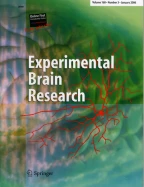Abstract
We recently reported that subjects performing a task that requires visual guidance of each step onto irregularly placed “stepping stones” usually fixate the next target of footfall just before they lift the foot to be repositioned, i.e. towards the end of that limb's stance phase. When negotiating the same walkway without ambient lighting, and with each stone's location indicated by a central light spot (LED), stepping and eye movements were unchanged. Under conditions of intermittent visual denial, in which all LEDs (the only visual cues) were temporarily extinguished at irregular intervals, temporal changes in the normal stepping pattern were sometimes observed, but stepping was not always affected. The primary effect of visual denial was on the leg that was in stance (foot in place on a stepping stone) at the moment of LED extinction, rather than on the leg that was in swing, and was an increase in stance duration, suggesting an effect on planning during this stance of the next swing towards the next target rather than on execution of the ongoing swing of the other leg. Subjects rarely failed to step onto the targets. Prolongations of stance under visual denial lasting 400 or 500 ms were less than 200 ms, much less than the duration of denial; subjects did not simply wait for the footfall target to reappear. There was no effect for denial lasting 300 ms; subjects performed as well as with a constantly visible target. Under 400 and 500 ms denial, there was no effect when the targets disappeared in the first 100 ms of stance (of the foot to be repositioned); stance durations were indistinguishable from control. This suggests that there is no crucial visuomotor processing by the control system(s) for eye and limb guidance until the target reappeared near the usual end of stance, when feedforward planning of the next saccade and/or swing to a target reaches a crucial stage, and is affected by intrusion of the period of visual denial. With longer (800 ms) denial there was an effect regardless of when in stance it began. A smaller effect of 800 ms denial sometimes visible in swing duration is attributable to interlimb coordination. Accurate saccades, followed by accurate steps, to the next target are almost always made, even when the target is invisible. Our results demonstrate that uninterrupted on-line visual information is not necessary for accurate stepping even when (as here) each step requires visual guidance. Also, since stance prolongations did not always result, and they were always much shorter than the periods of denial, we conclude that the visuomotor control mechanism(s) are robust in the face of substantial denial of all visual information including normally preferred inputs (foveal or peripheral images) at the normally preferred times. The fact that a saccade is still made to an invisible target location implies that this is useful in itself, since it does not result in a visible foveal image. We propose that skilled, visually guided stepping onto irregularly placed targets is executed under predominantly feedforward visuomotor control mechanisms, and suggest that the ability to function effectively in this way is dependent upon the integrity of the lateral cerebellum.
Similar content being viewed by others
References
Biguer B, Jeannerod M, Prablanc C (1982) The coordination of eye, head and arm movements during reaching at a single visual target. Exp Brain Res 46: 301–304
Bizzi E, Kalil RE, Tagliasco V (1971) Eye-head coordination in monkeys: Evidence for centrally patterned organisation. Science 173: 452–454
Carpenter RHS (1977) Movements of the eyes. Pion, London
Fisk JD, Goodale MA (1985) The organisation of eye and limb movements during unrestricted reaching to targets in contralateral and ipsilateral visual space. Exp Brain Res 60: 154–178
Herman R, Herman R, Maulucci R (1981) Visually triggered eyearm movements in man. Exp Brain Res 42: 392–398
Hollands MA, Marple-Horvat DE, Henkes S, Rowan AK (1995) Human eye movements during visually guided stepping. J Mot Behav 27: 155–163
Holmes G (1917) The symptoms of acute cerebellar injuries. Brain 40: 461–535
Land MF, Lee DN (1994) Where we look when we steer. Nature 369: 742–744
Laurent M, Thomson JA (1988) The role of visual information in control of a constrained locomotor task. J Mot Behav 20: 17–37
Lee DN, Lishman JR, Thomson JA (1982) Regulation of gait in long jumping. J Exp Psychol Hum Percept Perform 8: 448–459
Marple-Horvat DE (1995) Visual input to the lateral cerebellum. In: Ferrell WR, Proske U (eds) Neural control of movement. Plenum Press, New York
Patla AE (1991) Visual control of human locomotion. In: Patla AE (eds) Adaptability of human gait. Elsevier, New York, pp 55–97
Patla AE, Prentice SD, Robinson C, Neufeld J (1991) Visual control of locomotion: strategies for changing direction and going over obstacles. J Exp Psychol Hum Percept Perform 17: 603–634
Schiff W, Detwiler ML (1979) Information used in judging imending collision. Perception 8: 647–658
Stein JE, Glickstein M (1992) Role of the cerebellum in visual guidance of movement. Physiol Rev 72: 967–1017
Weir DJ, Stein JF, Miall RC (1989) Cues and control strategies in visually guided tracking. J Mot Behav 21: 185–204
Author information
Authors and Affiliations
Rights and permissions
About this article
Cite this article
Hollands, M.A., Marple-Horvat, D.E. Visually guided stepping under conditions of step cycle-related denial of visual information. Exp Brain Res 109, 343–356 (1996). https://doi.org/10.1007/BF00231792
Received:
Accepted:
Issue Date:
DOI: https://doi.org/10.1007/BF00231792
